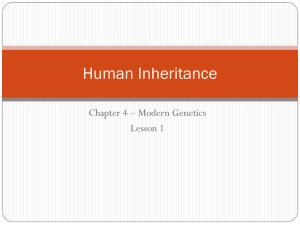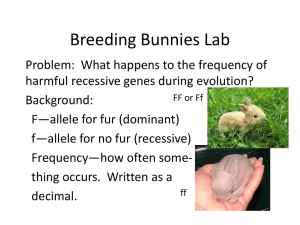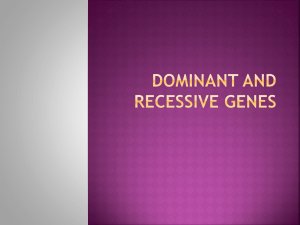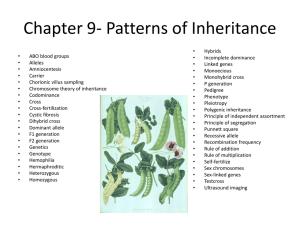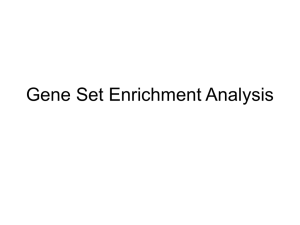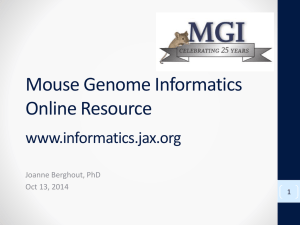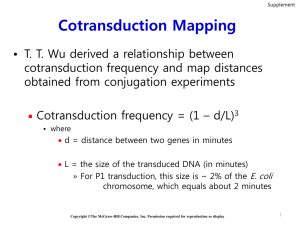File
advertisement
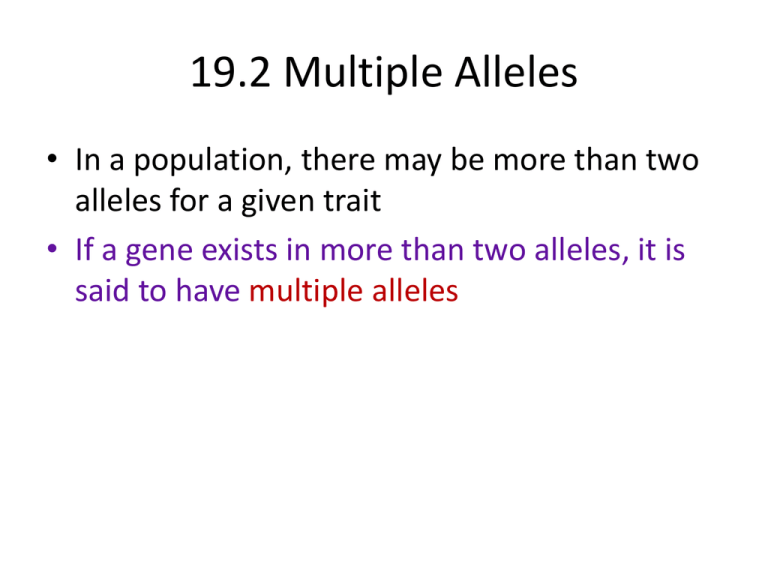
19.2 Multiple Alleles • In a population, there may be more than two alleles for a given trait • If a gene exists in more than two alleles, it is said to have multiple alleles Coat colour in rabbits • E.g. Coat colour in rabbit controlled by 3 alleles – C the allele for full colour (grey) – ch the allele for Himalayan (white coat, pink eyes, black/brown feet, ears, tail, tip of nose) – ca the allele for albino white • Through breeding experiments allele for full colour is dominant over the other alleles Himalayan is dominant over albino • Genotype of the various coat colours are shown below: • Several other alleles for coat colour have been found. • These alleles are recessive to the full colour but together with other alleles will show intermediate coat colour Phenotype Genotype Full colour CC, Cch, Cca Himalayan chch, chca Albino c ac a Human Blood Groups • E.g. Blood groups in Man • 4 blood groups in human population A, B, AB and O blood groups • Allele for A group IA • Allele for B group IB • Allele for O group IO • IA and IB are dominant over IO • IA and IB are co-dominant people with alleles IA and IB will have AB blood group • The blood groupings and their respective genotypes are shown: Blood group Genotype A IA IA or IA IO B IB IB or IB IO AB IA IB O IO IO The genotype IO IO is a homozygous recessive Worked Example 3 • Textbook Page 367 Mutations • Mutation is the sudden or spontaneous change in gene structure of a chromosome, or even the chromosome number, and may be inheritable • Some examples of mutations – Albinism – Sickle-cell anaemia – Down’s syndrome Sickle-cell anaemia • Results in slight chemical structural change in the genetic material (DNA) • Mutated gene is recessive and so expresses itself only in the homozygous recessive condition – – – – Have abnormal haemoglobin in their red blood cells Red blood cells become sickle shaped Unable to transport oxygen efficiently Severe anaemia is fatal, leading to death when young • In normal circumstances, such a harmful allele would have been eliminated from a population as the affected individual would die before reproducing • This disease common in West Africa where malaria is prevalent. Why? – Heterozygous individuals (Ss) more resistant to malaria than individuals who have two copies of the normal haemoglobin allele. Hence the heterozygous individual has a better chance in surviving and reproducing than normal individuals Chromosome mutation • Extra chromosome in the 21st pair of chromosome • Such people have 47 chromosomes in their body Down’s syndrome • Normally, zygotes with extra chromosomes fail to develop. One of the exceptions is a zygote with an extra chromosome 21. Mutagenic Agents • Rate of spontaneous mutation is very low • This rate can be increased greatly by the presence of certain agents known as mutagens • E.g. ultraviolet light, alpha, beta and gamma radiations, some chemicals (chloroform, organic solvents etc) Discontinuous vs Continuous variation • Variations are differences in traits or characteristics between individuals • Continuous variation is where there is a complete range of measurements from one extreme to another (individuals do not fall into distinct categories) • A continuous variation is brought about by the combined (or additive) effect of many genes • Discontinuous variation is where individuals fall into distinct categories e.g. ability to roll tongue, blood groups in man e.g. skin colour, height, weight TYS (4.2B) All MCQ Paper 2 Section A Q 2 and 4 and 5 Natural Selection • A process which results in the best adapted organisms in a population surviving to reproduce and so pass on more of their genes to the next generation • Mutation provides new genes or alleles, and hence variation, for natural selection to operate on. • New breed of organisms may change so much that they become new species evolution Fig. 19.20 Artificial Selection • Selection is a method used to produce plants and animals with desirable traits – E.g. Selecting plants that produce seeds with high oil content in soybean – Cultivated sugar cane resistant to disease and also rich in sugar – Cows that produce more milk and can thrive in warm climate • Read pg 374 and 379 for more details Artificial Selection Natural Selection Man selects the varieties of organisms that suit his needs Selection occurs when natural environmental conditions change Varieties are produced by selective breeding Varieties are produced by mutations TYS (4.2A) • All MCQ • Paper 2 (Section A) Genetic Engineering Nature of genes • Genes inherited from our parents found in chromatin threads (chromosomes) in the nucleus • 23 from mother, 23 from father • Each chromatin thread is made up of DNA wrapped around proteins • The 2 DNA strands form a double helix Gene • A small fragment of DNA which controls the formation of a single protein or enzyme • There are many genes along the DNA strand. • Each gene stores a message (genetic code) which determines how an enzyme or protein should be made in the cell • Each protein or enzyme contributes to the development of a certain characteristics in our bodies Genes • If genetic code is altered, it may affect our body structure or function • E.g. Sickle cell anemia – The genetic code for one amino acid in the haemoglobin protein was changed slightly, resulting in a code that produced in another amino acid in its place. • In many cases, more than one type of polypeptide chain is involved in the formation of a protein molecule. E.g. insulin Genes • Many genes are switched off, except when needed in the relevant cells in the body • For example, the genes for insulin production only express themselves in special cells in the pancreas • Oncogenes (cancer genes) may be activated in our cells and cause cancer later in our lives • • • • Transfer of Genes from One Organism to Another Genetic engineering is a technique used to transfer genes from one organism to another Certain genes may be cut off from the cells of one organism and inserted into cells of another organism of the SAME or DIFFERENT species A vector (plasmid) is used to transfer the gene The transferred gene can express itself in the genetically engineered organism Transgenic bacteria and the production of insulin • Gene (from human) for making insulin transferred to bacterial cell • Gene causes bacteria to produce insulin • Any organism which acquires a foreign gene is called a transgenic organism • In this case, the bacterium which has the insulin gene is a transgenic bacterium Advantages • New insulin produced by genetic engineering is exactly the same as human insulin. Hence, no danger or rejection by people who use the insulin to control their sugar level • Also, the genetically engineered bacteria multiply rapidly to form a large population which makes large quantities of the gene product (e.g. insulin) • Large scale production of insulin with the use of fermenters is done. Insulin is then extracted and purified Advantages of G.E. • Can insert a gene from any organism into a plant or an animal • No transmission of defective genes unlike selective breeding • G.E. experiments with individual cells, which can reproduce rapidly in the lab in a small container • Increases productivity and efficiency in the breeding of organisms. This increases profitability (e.g. transgenic salmon grows faster and requires less food) Risks of G.E. • Allergy to transgenic food which people eat • Genes that code for an antibiotic resistance accidentally incorporated into bacteria that cause diseases to humans • Some people may deliberately create combination or genes which they may use in chemical or biological warfare 4.2B MCQ 73, 74, 75, 76, 78, 81, 85, 87, 88, 89, 91, 94, 95, 96, 99, 100 Section A 12, 25 Topic 4.2A MCQ Q20 – 32 Section A Q2 Topic 4.2B MCQ Q54 – 69 Section A 19, 21, 23

